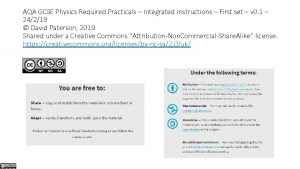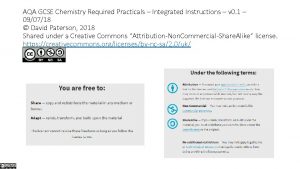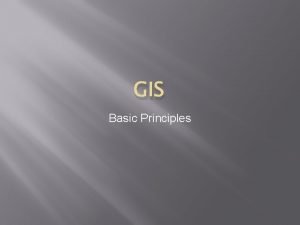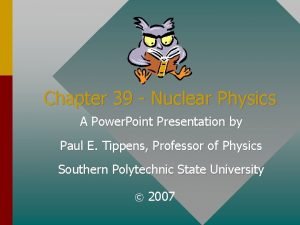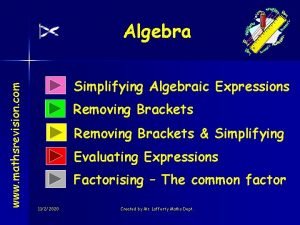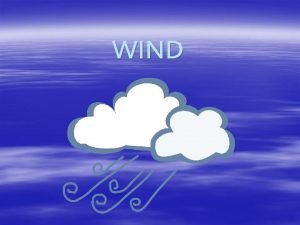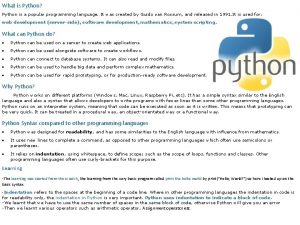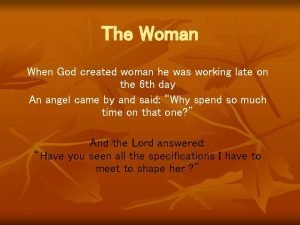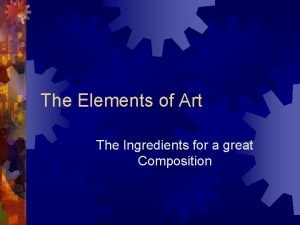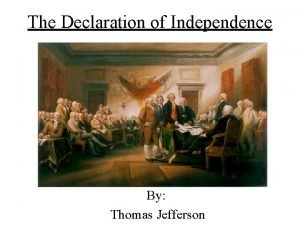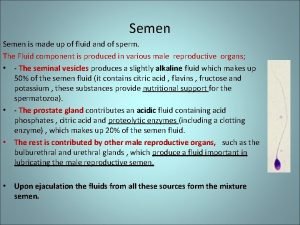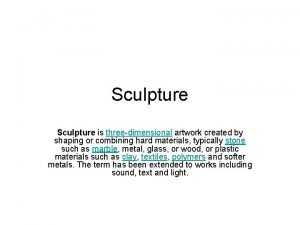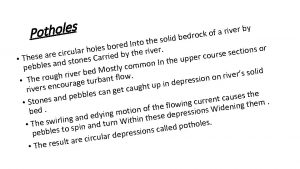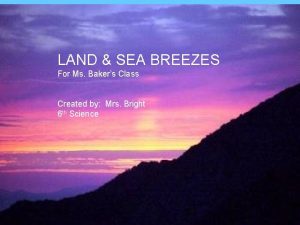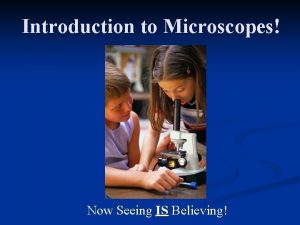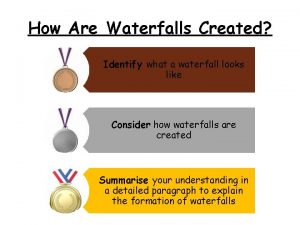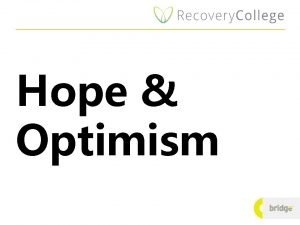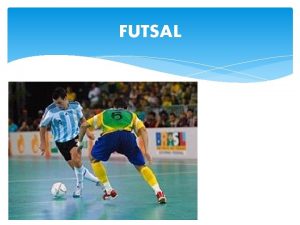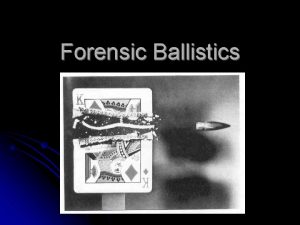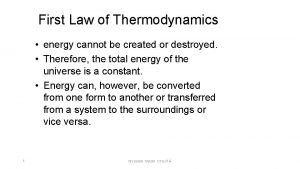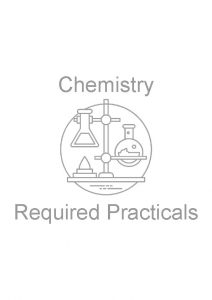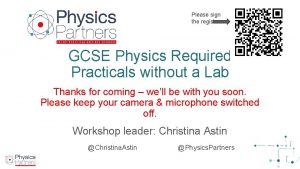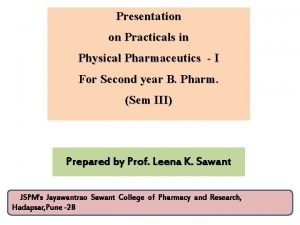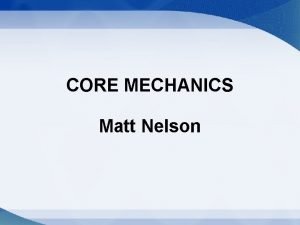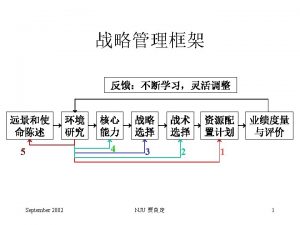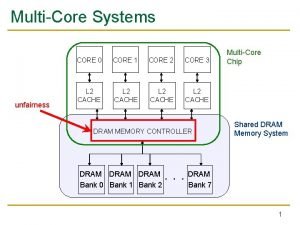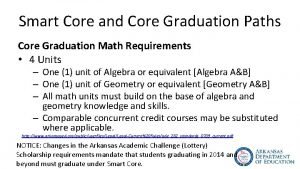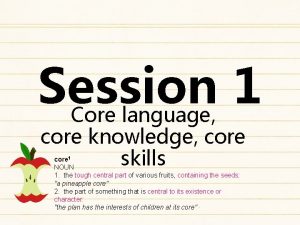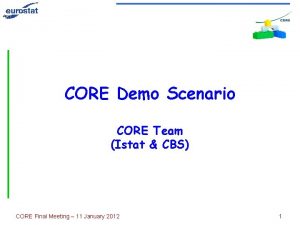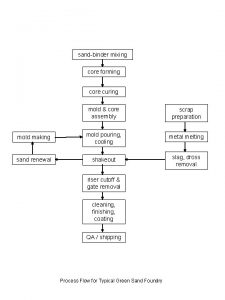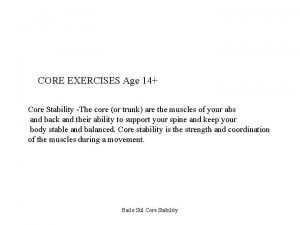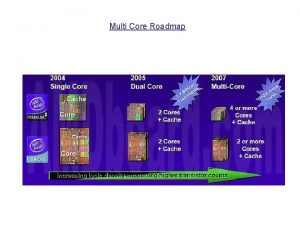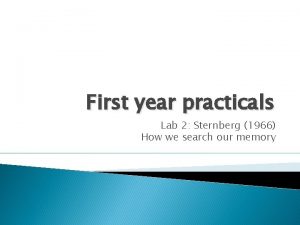Physics Core Practicals This presentation is created to














































- Slides: 46

Physics Core Practicals This presentation is created to be viewed in present mode. This allows testing of your true understanding. Bold for separate physics only

Equations Variables Equipment Core Practicals Key Components Vocabulary Errors & Improvements Safety

CP 1 – Investigating F M & a • What do the symbols above represent (and what is their unit)? • • F = Force (Newtons = N) • M = Mass (Kilograms = kg) • a = acceleration (meters per second squared = m/s 2) What equations are related to acceleration and force? What is the purpose for all of the labelled equipment on the picture to the right? Why light gates and not a stop watch? Why is the brick sloping the board? What could hurt you from this experiment? How does this represent inertial mass?

Equipment • Trolley • Ramp • Masses and mass hanger • Card • Light gates

Light Gates • Advanced light gates can calculate speed • Others only measure time by the measuring the time their laser beam is blocked • This is why we measure the width of the card on the trolley • Because with the width or distance we can calculate speed (speed = distance ÷ time) • Two light gates are needed as we need two speeds (change in speeds) to measure acceleration

Variables Investigating Force Investigating Mass • Changing pulling force (independent variable) • Measuring acceleration (dependent variable) • Cart mass remains constant • Changing mass of cart (independent variable) • Measuring acceleration (dependent variable) • Pulling force remains constant

CP 1 - Equations What is the equation for acceleration? What is the equation force? • a = (v – u) ÷ t • a = acceleration (m/s 2) • v = final (2 nd) velocity (m/s) • u = initial velocity (1 st) (m/s) • t = time (s) • F=mxa • F = Force (N) • m = mass • a = acceleration (m/s 2)

Errors and Improvements • Why use a light gate rather than a stop watch? • Human error will cause inaccuracies with a stop watch • How can we reduce or remove friction from this experiment? • Reduce by adding a lubricant (oil, grease) to the wheels/axles or using a surface with less friction (ice) • Remove by sloping the board to use the gravitational force to compensate for the friction force.

Safety • What could cause the scientist danger? • Weights falling on limbs • Fixed by adding padding to landing spot • Ensure scientist are wearing hard covered shoes

Vocabulary • Inertial Mass • A measure of how difficult it is to change the velocity of an obecjt • Or the ratio of force over acceleration (m = F/a)

Understanding Questions

CP 2 – Measuring Waves in Solids and Liquids • What are two equations for wave speed? • How can we measure the following: • • Frequency Wavelength Distance Time

Equipment In Water In Solids • Ripple tank • Ruler • Stop watch • Pipe • Stand • Rubber bands • Hammer • Meter stick • Frequency Analyzer

Ripple Tank • Creates identical waves that propagate across the water • Support is connect to a motor to control speed of waves • Shadow below allows one to measure wavelength. • Wooden bar must be adjusted to ensure waves are parallel to one another

Variables Speed of Sound in Water Speed of Sound in Solids • Measuring wavelength of a wave • Measuring length a rod to find (distance peak to peak) wavelength (λ = 2 L) • Measuring frequency of wave • Measuring frequency with a (counting number of waves in a frequency analyzer duration of time)

CP 2 - Equations Wave speed Wave Speed • v=d/t • v = velocity (m/s) • d = distance (m) • t = time (s) • v=fxλ • v = velocity (m/s) • f = frequency (Hz = 1/s) • λ = wavelength (m)

Errors and Improvements In Water In Solids • Stop watch used therefore human error (could use camera equipment to remove) • Ambient noise in room effects frequency accuracy

Safety In Water In Solids • Use of water in the lab and potential spills • Metal rod can fall from rubber band supports if struck too hard, danger to feet below

Vocabulary • Frequency • Number of waves per second • Wavelength • Length of one wave (peak to peak) • Amplitude • Half the total height of the wave, distance from rest point to peak • Period • The amount of time taken for one wave to pass a point • Wave velocity • The rate at which a wave changes its position

Understanding Questions

CP 3 – Investigating Refraction • What is refraction? • Why does refraction occur? • How do we measure the angles of incidence and refraction? • (Triple) What is total internal reflection? • What are the 2 conditions for total internal reflection?

Equipment • Ray box • Glass block • Protractor

Variables • Independent variable is the incident angle • Dependent variable is the refracted angle • Using the same glass block and laser (light source)

CP 3 - Maths • No equations are needed but the maths skill of creating and summarizing a graph is needed for this core practical

Errors and Improvements • Inaccuracies with measuring correct angles • Use of white paper under the block help see rays • Polar graph paper can also be used to help measure angles

Safety • Light source should not be pointed in anyone’s eyes • Handling of glass block safely

Vocabulary • Reflection • The wave bounces off a surface (at an equal angle) • Refraction • Light is bent as it enters a new medium (due to changes in speed) • Transmission • Light is unaffected as it travels through the medium • Absorption • Energy from the light is absorbed and often turned into thermal energy • Total Internal Reflection • When light reflects at a medium boundary instead of refracts

Understanding Questions

CP 4 – Investigating Thermal Energy • Do humans radiate energy? • How does the wavelength of light emitted from an object depend on the its temperature? Or what color flame is the hottest? • If something is at a constant temperature how is its absorbed/radiated energy related?

Equipment • Boiling Tubes • Different color wrappings for tubes • Thermometer • Stopwatch • Kettle

Variables • Independent variable color of boiling tube • Dependent variable temperature change • Ensure starting temperature and volume of water in each test tube are the same. Along with amount of cooling time.

CP 4 - Maths • No equations are needed but the maths skill of creating and summarizing data tables are required

Errors and Improvements • Digital thermometers can improve accuracy • Add insulator to reduce heat lost

Safety • Hot water should be poured carefully • Boiling tubes can become hot • Glass ware handled carefully

Vocabulary • Absorption • Energy being added to the system • Emission • Energy leaving the system

Investigating Absorption • What would you additionally need in order measure the absorption of energy by these different colors?

Understanding Questions

CP 5 – Investigating Resistance • What is the circuit symbol for: • Bulb, battery, wire, resistor, ammeter, voltmeter • What is the same in a series circuit? • What is the same in a parallel circuit? • What is voltage, current, and resistance? • What are their units? • How are resistors in series different from resistors in parallel? • How are the resistances of lamps and resistors different? • Draw a circuit to investigate a bulb’s resistance.

Equipment • Battery • Wires • Bulb • Ammeter • Voltmeter

Voltmeters and Ammeters • Voltmeters are connected in parallel • Ammeters are connected in series

Variables • Independent variable voltage (potential difference) over the bulb changed by changing battery’s voltage • Dependent variable current running through the bulb

CP 5 - Maths • V=Ix. R • V = Voltage (V) • I = Current (A) • R = Resistance (Ω) • Maths skill of plotting a line-graph and calculating its gradient

Errors and Improvements • Errors come from internal resistance inside the battery and wires • Improvements are using higher quality equipment with lower internal resistances

Safety • Never use a higher than recommended voltage • Turn circuit off in between measurements. (Why? ) • Circuit components will heat up if left on too long and can cause skin burns • Report any faulty equipment (anything with exposed wires)

Vocabulary • Voltage • The amount of energy given to a charge (what pushes the electrons) • Current • The movement of charge (electrons) • Resistance • Controls the current of a circuit

Understanding Questions
 Aqa a level physics required practicals
Aqa a level physics required practicals Aqa gcse chemistry required practicals
Aqa gcse chemistry required practicals Tweetmap
Tweetmap The brittle, rocky outer layer of earth
The brittle, rocky outer layer of earth The strong lower part of the mantle
The strong lower part of the mantle What are the 3 main layers of the earth? *
What are the 3 main layers of the earth? * Core rigidity
Core rigidity Modern physics vs classical physics
Modern physics vs classical physics University physics with modern physics fifteenth edition
University physics with modern physics fifteenth edition How to write physics ia
How to write physics ia Nuclear physics topics for presentation
Nuclear physics topics for presentation Diameters of fetal head
Diameters of fetal head Cephalic presentation
Cephalic presentation Remove the brackets and simplify questions
Remove the brackets and simplify questions Wind is created by
Wind is created by What is python
What is python The highest part of a wave
The highest part of a wave What is the dreamtime story of how uluru was created
What is the dreamtime story of how uluru was created When god made woman he gave her
When god made woman he gave her The truman doctrine worksheet answers
The truman doctrine worksheet answers Horizontal revolution marketing definition
Horizontal revolution marketing definition Federal reserve system
Federal reserve system Generally restful like the horizon
Generally restful like the horizon Declaration of independence all men are created equal
Declaration of independence all men are created equal Who created the fictional detective sherlock holmes
Who created the fictional detective sherlock holmes How is semen made
How is semen made A 3-d work of art created by shaping or combining materials
A 3-d work of art created by shaping or combining materials How are potholes created
How are potholes created Rank size rule example
Rank size rule example Large monuments created from huge stone slabs
Large monuments created from huge stone slabs What are sound devices in poetry
What are sound devices in poetry Griffin ford latin american model
Griffin ford latin american model Land and sea breezes animation
Land and sea breezes animation What is this part
What is this part Types of black holes
Types of black holes How waterfalls are made
How waterfalls are made How are stars created
How are stars created Broaden and build model
Broaden and build model Scallated
Scallated When did hinduism start
When did hinduism start Who invented futsal in 1930
Who invented futsal in 1930 How natural gas is formed
How natural gas is formed Introduction to forensic ballistics
Introduction to forensic ballistics Energy cannot be created or destroyed
Energy cannot be created or destroyed Package research case closed
Package research case closed Isolation emphasis art
Isolation emphasis art Title of the multimedia created
Title of the multimedia created
